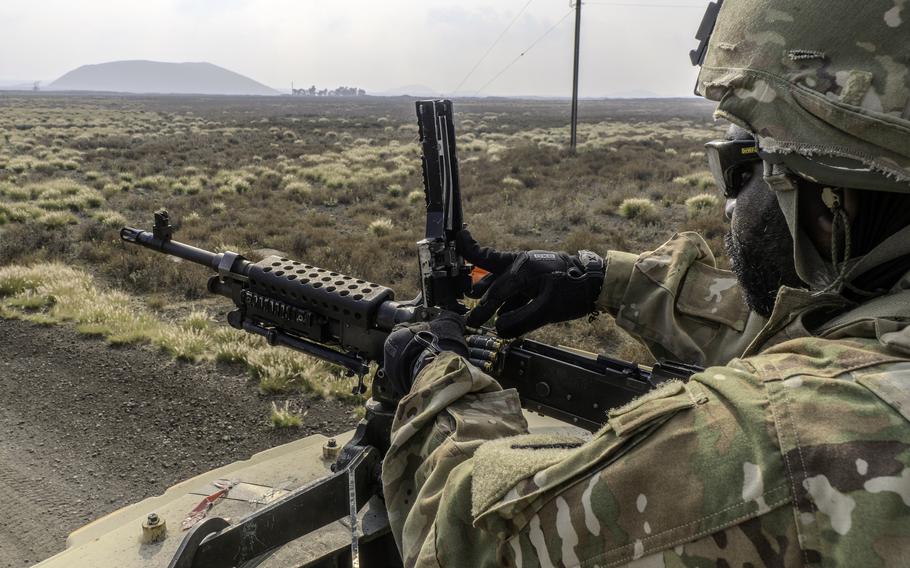
A soldier with the 25th Combat Aviation Brigade, 25th Infantry Division loads a machine gun at the Pohakuloa Training Area in Hawaii, Feb. 28, 2025. (Charles Clark/U.S. Army)
The Army’s plan to renew a lease for almost 20,000 acres of state land on Hawaii’s Big Island carries significant harmful effects on biological resources, cultural practices and environmental justice, according to the final environmental impact statement released Friday.
The Army is seeking to renew a lease for 19,700 acres that make up part of the Pohakuloa Training Area, a 132,000-acre live-fire training range made up of mostly federally owned land.
The state granted the Army a 65-year lease for $1 in 1964 for the use of 23,000 acres.
The Army maintains that the Pohakuloa, including much of the leased state land, is essential to maintaining the nation’s military readiness.
Pohakuloa is the largest contiguous live-fire range and maneuver training area in Hawaii and is regarded as the Pacific region’s premier military training center, the Army said in a fact sheet accompanying the environmental statement.
“It is the only U.S. training area in the Pacific region where [U.S. Army Hawaii] units can complete all mission-essential tasks and the only U.S. training area in Hawai‘i that can accommodate larger than company-sized units for live-fire and maneuver exercises,” the fact sheet states.
The training area is central to U.S. Army Pacific’s Joint Pacific Multinational Readiness Center training held annually in the state. The site is also key in the Navy’s biennial Rim of the Pacific exercise.
The Army has in recent years worked through the required environmental regulations needed to begin negotiations to renew the state lease ahead of its expiration in 2029.
The environmental statement also considers three other lease scenarios that are not being pursued. In two alternatives, the Army would lease 22,750 or 10,100 acres. In a final scenario, the Army would not lease any of the state land.
The Army said in a news release Friday that it would wait 30 days before issuing a decision on the lease.
If it chooses to move forward, the Army would begin negotiating with the state for its desired lease. The length would be determined in those negotiations, the service said.
The Army conceded in the environmental statement that executing a new lease prior to the expiration of the current one would be “arduous.” That is because the Army would need to petition the state to authorize a special subzone on the land that would allow military use of the acreage, and that request is likely to be contested by opponents of a renewed lease.
Two public comment periods held for draft environment statements issued in 2022 and 2024 garnered hundreds of responses, many opposing the renewal.
Jim Albertini, president of the group Malu ‘Aina, has long sought the end of military training at Pohakuloa entirely.
“Pohakuloa is zoned State Conservation land, the highest protected land status,” he said in an email Tuesday.
“Pohakuloa is a sub-alpine tropical dry-land forest — one of the world’s rarest kinds of ecosystems and the habitat for endangered plant and animal species, as well as many cultural and historic sites. Bombing and shelling is not a compatible use with Conservation land status.
“Wildfires started by PTA bombing and shelling have burned tens of thousands of acres, including more than 12,000 acres off the base, destroying additional endangered species habitat.”
An online petition calling on Hawaii’s governor and the board of the Hawaii Department of Land and Natural Resources to not renew the lease had more than 10,000 signatures as of Wednesday.
A Hawaii judge in 2018 ruled that state officials had failed to ensure the Army maintained the range and protected Hawaiian cultural interests — as required in the lease — in a lawsuit filed by Native Hawaii cultural practitioners.
If granted the lease renewal, the Army proposes adopting mitigation measures to counter the findings of significant adverse impact regarding biological resources, Hawaiian cultural practices and environmental justice.
Among them would be developing a formal plan for quarterly access to the property for native Hawaiian organizations and others; installing interpretive panels at the installation’s cantonment area; negotiating an agreement with the state to allow the Army to monitor wildfires; and researching feasibility of biological controls of an invasive grass.